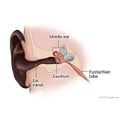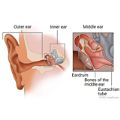Our Health Library information does not replace the advice of a doctor. Please be advised that this information is made available to assist our patients to learn more about their health. Our providers may not see and/or treat all topics found herein.
Topic Contents
Blocked Eustachian Tubes
Condition Basics
What are blocked eustachian tubes?
The eustachian (say "you-STAY-shee-un") tubes connect the middle ears to the back of the throat. The tubes help the ears drain fluid. They also keep air pressure in the ears at the right level.
When you swallow or yawn, the tubes open briefly to let air in to make the pressure in the middle ears equal to the pressure outside of the ears. Sometimes fluid or negative pressure gets stuck in the middle ear. The pressure outside the ear gets too high. This blockage causes ear pain and sometimes trouble hearing.
What causes them?
Swelling from a cold, allergies, or a sinus infection can keep the eustachian tubes from opening. This leads to pressure changes. Fluid may collect in the middle ear. The pressure and fluid can cause pain. You also can have ear pain from changes in pressure while you are flying in an airplane, driving up or down mountains, or scuba diving. Fluid in the ear can lead to an infection (acute otitis media). Young children have a high risk of ear infections, because their eustachian tubes are shorter and more easily blocked than the tubes in older children and adults.
What are the symptoms?
Blocked eustachian tubes can cause several symptoms. For example, your ears may hurt or feel full. You may have ringing or popping noises in your ears. Or you may have hearing problems or feel a little dizzy.
How are they diagnosed?
Your doctor will ask about your symptoms. Your doctor will look in your ears. The doctor also may check how well you hear.
How are blocked eustachian tubes treated?
Blocked eustachian tubes often get better on their own. For adults, decongestants that you take by mouth or spray into your nose may be helpful. If you have allergies, the doctor may prescribe a steroid medicine that you spray into your nose. Follow the instructions carefully.
If you have an ear infection, the doctor may prescribe antibiotics. Take them as directed. Do not stop taking them just because you feel better. You need to take the full course of antibiotics.
In some cases, people need surgery for a blocked eustachian tube. The doctor makes a small cut in the eardrum to drain fluid and to make the pressure the same inside and outside the ear. Sometimes the doctor will put a small tube in the eardrum. The tube usually will fall out over time.
How can you prevent them?
If you have allergies, talk to your doctor about how to treat them so your sinuses stay clear and your eustachian tubes stay open. When you're in an airplane, you can chew gum, yawn, or drink liquids during takeoff and landing. Try the exercise where you gently blow while holding your nose shut.
Related Information
Credits
Current as of: October 27, 2024
Author: Ignite Healthwise, LLC Staff
Clinical Review Board
All Ignite Healthwise, LLC education is reviewed by a team that includes physicians, nurses, advanced practitioners, registered dieticians, and other healthcare professionals.
Current as of: October 27, 2024
Author: Ignite Healthwise, LLC Staff
Clinical Review Board
All Ignite Healthwise, LLC education is reviewed by a team that includes physicians, nurses, advanced practitioners, registered dieticians, and other healthcare professionals.
This information does not replace the advice of a doctor. Ignite Healthwise, LLC disclaims any warranty or liability for your use of this information. Your use of this information means that you agree to the Terms of Use and Privacy Policy. Learn how we develop our content.
To learn more about Ignite Healthwise, LLC, visit webmdignite.com.
© 2024-2025 Ignite Healthwise, LLC.






